

Timo Ahonen, professor, emeritus University of Jyväskylä and Niilo Mäki Institute 2019
When going through the next pages you will learn, what happens in the brain when the child is learning to write. What brain
networks and areas are needed and why handwriting is so important skill in child development and learning.
Writing is – “Language by hand”
Nowadays different digital equipments are replacing hadwriting with pen or pencil. Therefore some teachers and parents may wonder, if the time used for practicing handwriting is waisted time and not anymore needed?
• But based on observations in the classrooms about 30-60% of the
school days is still used in writing activities.
• Especially handwriting with the pen includes advanced motor activity and is based of “internal representations” of the letter shapes and words in our brain. In writing these representations are retrieved from our long-term memory.
• Lack of automatization of the retrieval and generation processes is the crucial restriction of the child who is practicing handwriting.
What is the brain basis of writing and what
we know about it?
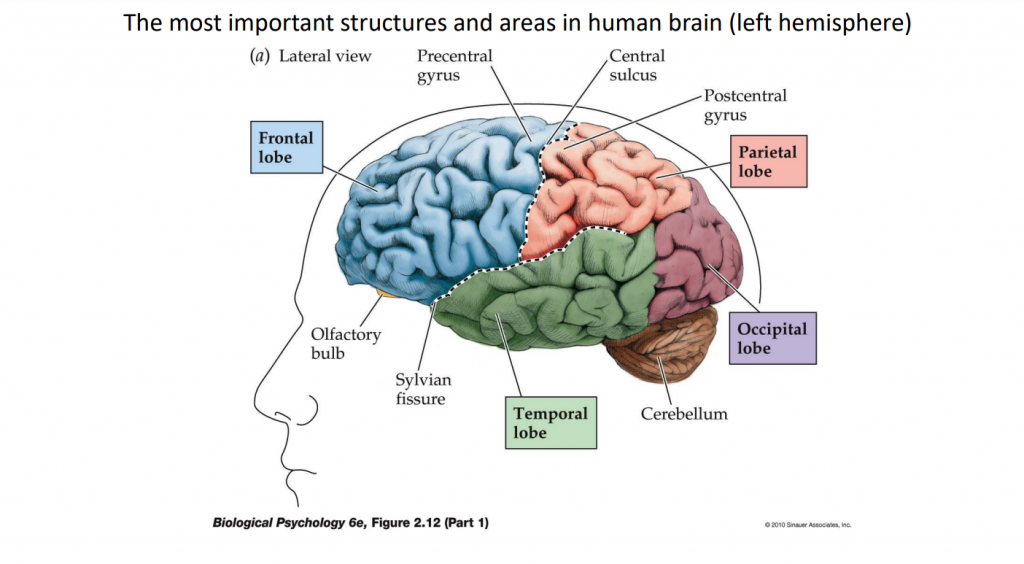
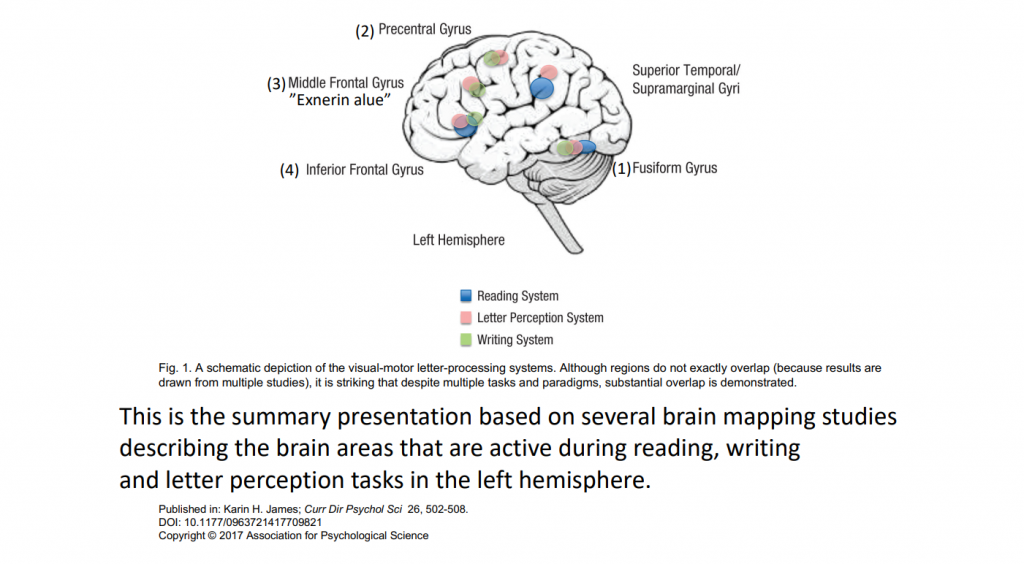
In the next pages we will go through these brain areas step by step so that you will learn the overall structure of neural network of writing in the brain.

Fusiform gyrus
Letter processing in the literate individual involves the reqruitment of left fusiform gyrus. Processing of fingle letters and letter strings
happens here. This area is involved also in spelling (especially
correcteness of spelling). s kielellisessä prosessoinnissa liittyen
kirjoittamisen oikeellisuuteen.
• This area in left hemisphere activates always when we see letters or words thats why this are is also called ”visual word form area”.
• This area is connected also to recognition of letter forms. That’s why letter perception always also activates brain areas that are used to produce letters.
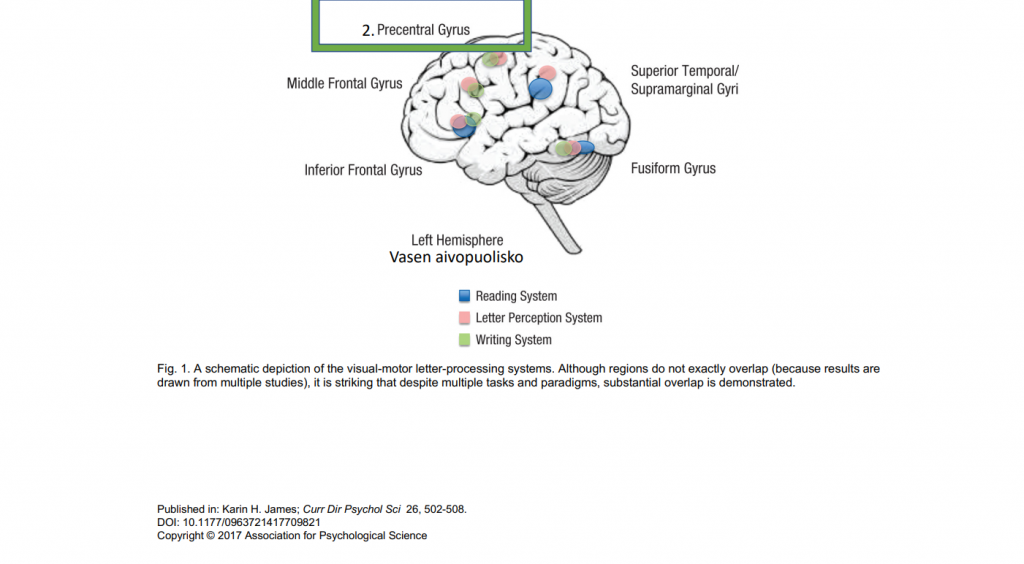
Precentral gyrus
The neural pathways to muscles originate from this area and it is also centre for producing motor activities.
• In this are our hands have very large representations as you see in the ”Homunculus” in the next slide. This enables the production of very accurate and exact fine motor activities and movements that are needed in handwriting.
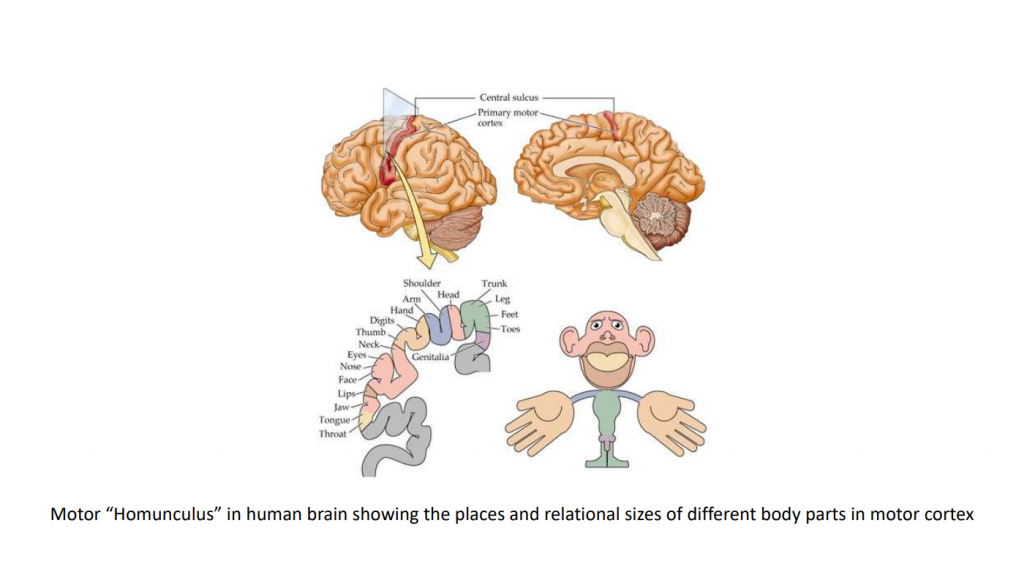
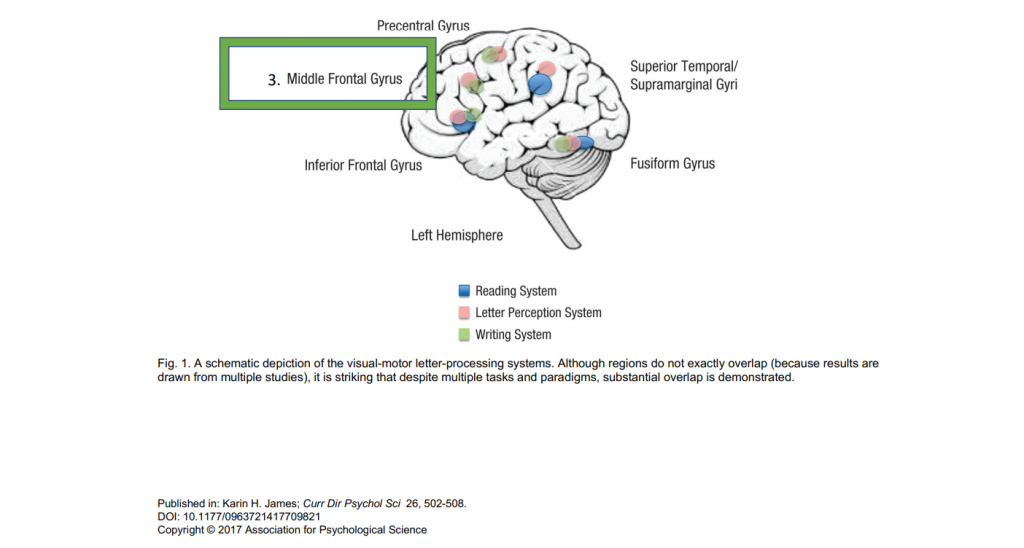
Middle frontal gyrus
This area is important in writing, because in this area the word forms based on the orthography we are using are created and stored.
• This area is active in language related tasks, when writing as a motor performance is carried out.
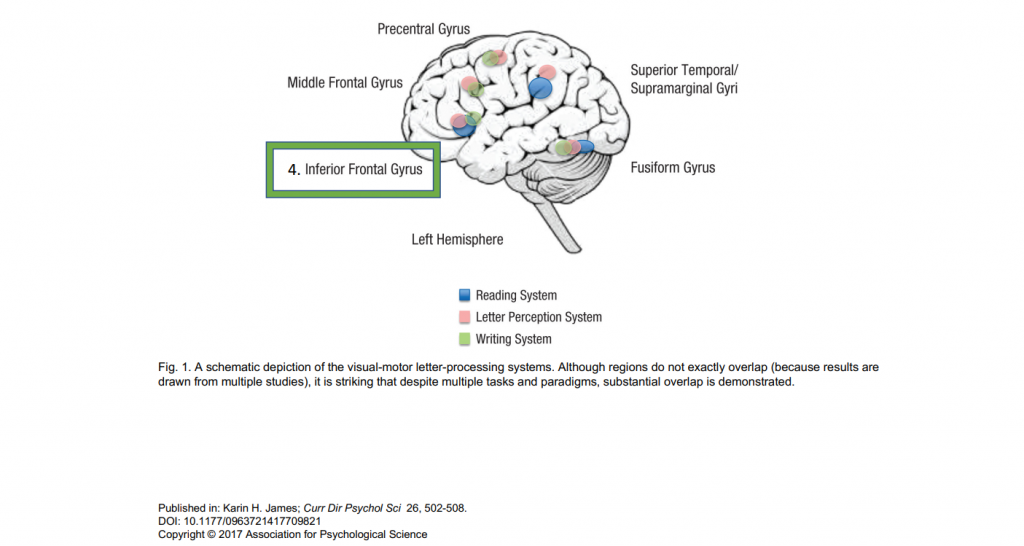
Inferior frontal gyrus
• This area is central part of the our language system in perceiving and production of speech.
• This area connects the writing system to the other linguistic
mechanisms in the brain.
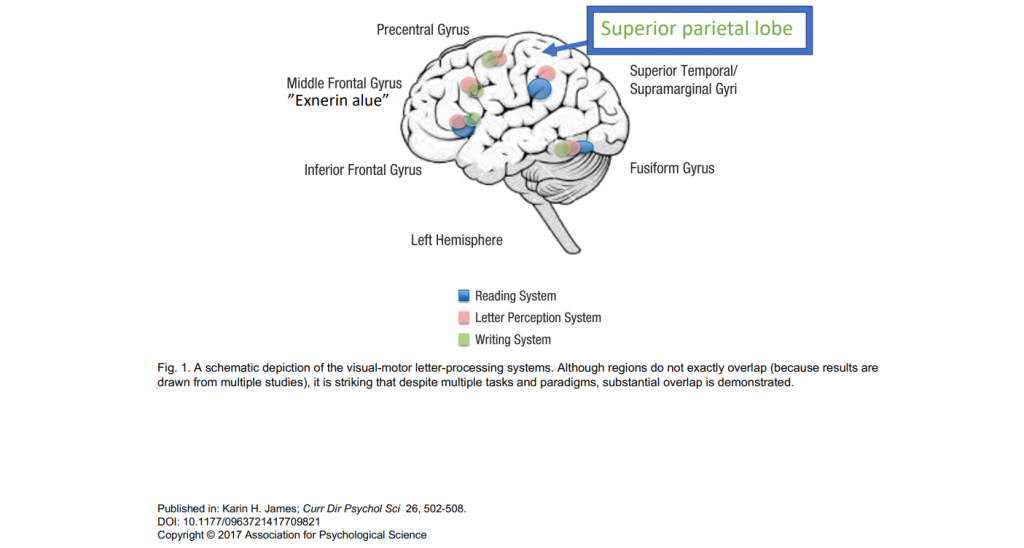
Superior parietal lobe
Sensory pathways from hands and fingers end to this area and this
area is important for the kinesthetic feedback needed in handwriting.
• We also know that motor programs in writing are stored in this area in left hemisphere.
• In the next slide you see see how similar handwriting is, althouh it is produced with different mens (a. With right dominant hand, b. Right hand, wrist immobilized, c. With left hand, d. With the pen gripped between the teeths, e. The pen attached to food) – because all these examples are based on the same motor programs in the brain.
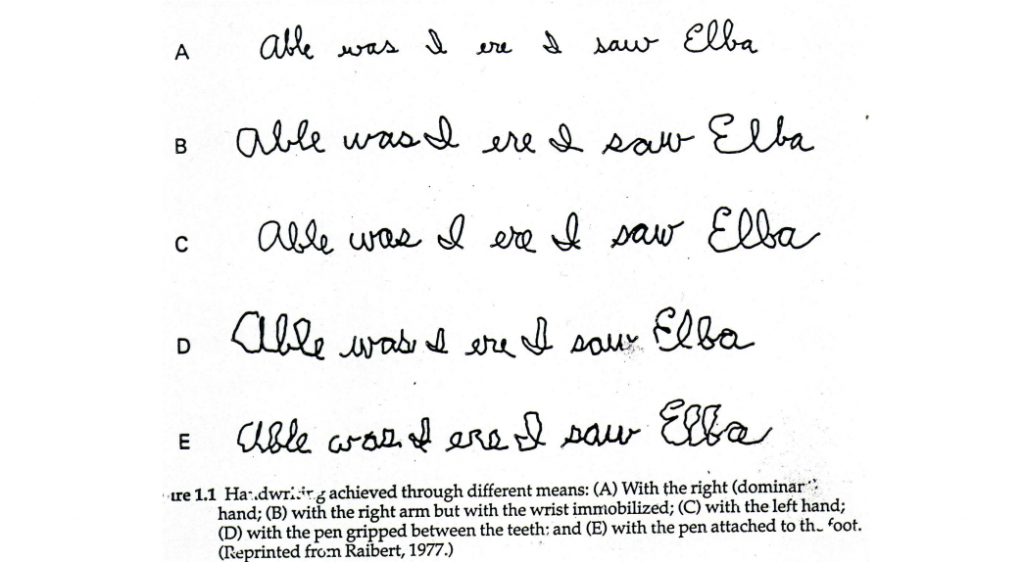
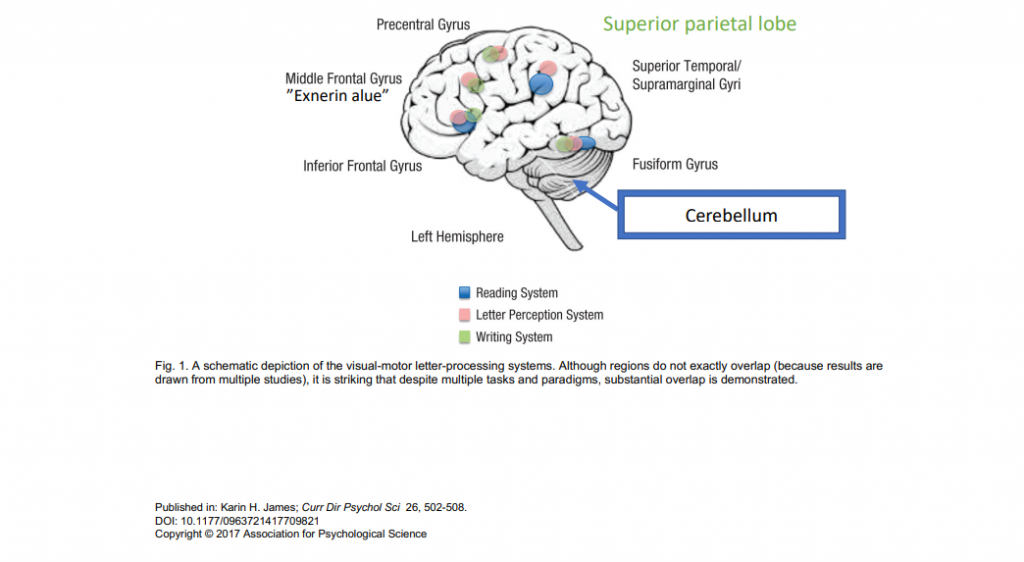
Cerebellum
In addition to described areas in the Cerebral cortex, also some parts of the right Cerebellum seems to be active during writing.
• Funtional disorders of the Cerebellum cause difficulties in movement timing, accuracy and flexibility and also make learning of new motor skills more difficult.
Summary:
• The brain mechanisms and neural networks are working dynamically together. This means that writing is not based on one single brain structure – it is based on neural system consisting of different brain areas and connections between them. The whole system or network is needed and activated when we are writing.
• This system consists of different brain areas working together and
information between these areas go to both directions between
these areas.
Cooperation between the brain areas and how active different areas are during writing tasks depends on to the experience of the child and at what stage of learning and practicing handwriting skills the child is.
• Neural networks arise and develop in the interaction between the
child and the teacher!
Learning to write
• Learning how to write relies on very similar organizing principles to those for learning other types of motor tasks.
• When learning to write the child’s own activity is the most
important issue. It is very difficult to learn to write just by looking at
the other people who is writing.
• To learn to write fluently and without too much effort and
attentional load (as the adult writers do), needs many years of
active practicing, starting about the age of five and continuing to
the age of ten. In that sense, learning handwriting is similar to
learning how to play a musical instrument.
When writing with the pen, the child needs to produce every letter
accurately. But when typing (with smartphone or computer) the
motor programmes do not require the mastery of letter forms and
this subprosess is not needed in typing.
• It is interesting that when child is practicing handwriting it is not so important ”how elegant and correct” the letters or letter forms that child produces are at the beginning.
• For learning, the most important is issue is the child’s own activity and the variable letter forms child produces. This variation in letter forms as a matter of fact will strengthen the motor programs of the letters in the long-term memory
• Writing with pen or pencil includes many positive impacts on cognition and therefore the time needed for fine motor practicing is not useless or waisted time.
• It will support child’s overall development!
• Therefore it is important to allocate time for it during the first school years.
When typing with digital equipments the sensomotor experiences
(tuch, proprioception, motor activity, visual perceptions) are very
much different and stingy than when writing with pen.
• Therefore writing with the pen seems to support learning to read
better than typing.
• Also making the handwritten notes e.g. during the lectures, seems to help memory better than typing with digital equipments.
• On the other hand typing may also have it’s own strengths e.g. it may support motivation and willingness to write.
• Both of these skills are needed also in the future!
Recommended readings:
James, K. (2017). The importance of handwriting experience on the
development of the literate brain. Current Directions in Psychological Science, 26, 502–508.
James, K. H. & Engelhardt, L. (2012). The effects of handwriting experience on functional brain development in pre-literate children. Trends in Neuroscience and Education, 1, 32–42.
Palmis, S., Danna, J., Velay, J.-L. & Longcamp, M. (2017). Motor control of handwriting in the developing brain: A review. Cognitive Neuropsychology, 34, 187–204.